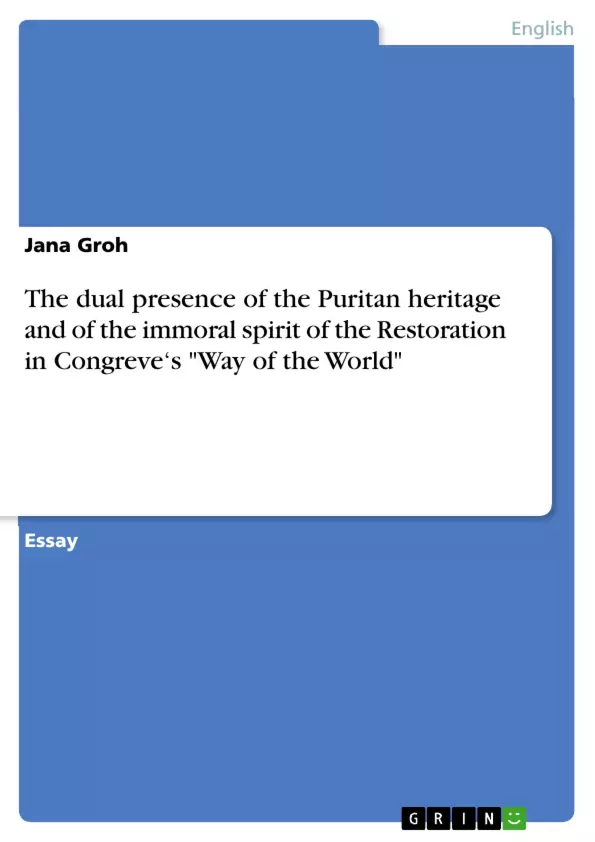After theatres in England were reopened again in the course of the Restoration in 1660, after a period of eighteen years, the English theatre developed very much. Many plays were written for the two theatre companies in London, now in the tradition of the Restoration. Different forms of Restoration plays developed, e.g. the Heroic Tragedy, and the Comedy of Manners. But not only the Restoration and the following Glorious Revolution from 1688 were made a subject, but also the former Puritan period. Both periods differ very much in their politics, their ideas, and their way of living. When William Congreve‘s comedy The Way of the World was published in 1800 and performed by The Dukes‘s Men theatre company at Lincoln‘s Inn Fields in the same year, it was already more than fourty years after the Puritan period and exactly fourty years after the Restoration. By then the constitunional monarchy was well established, and even the ideas of the Restoration were not that uptodate any more. Nevertheless Congreve and his works are seen as part of the Restoration tradition, and his drama The Way of the World even makes not only the Restoration time, but also the Puritan period a topic. Here Congreve acknowledges the dual presence of the Puritan heritage and of the immoral spirit of the Restoration. He does this by presenting both Puritan and Restoration formed characters, by including ideas of both sides, and by refering to exponents and terms of these as I am going to show in the following.
Inhaltsverzeichnis (Table of Contents)
- The dual presence of the Puritan heritage and of the immoral spirit of the Restoration in Congreve‘s Way of the World
- The Restoration Characters
- The Puritan Character Lady Wishfort
- The Different Directions in the Play
- Puritanism, Hedonism, and Epicurianism
- Exponents and Terms of the two Directions
- The Dual Presence Becomes Obvious
Zielsetzung und Themenschwerpunkte (Objectives and Key Themes)
This work examines how William Congreve's play "The Way of the World" reflects the dual presence of the Puritan heritage and the immoral spirit of the Restoration era in England. It analyzes how characters, themes, and references to both periods intertwine throughout the play.
- The portrayal of Restoration characters and their moral complexities
- The contrasting presence of Puritan values, particularly embodied by Lady Wishfort
- The representation of philosophical ideas prevalent during the Restoration, including contract theory and hedonism
- The interplay of Puritan and Restoration ideas through characters' actions and dialogue
- The use of literary references and historical figures to highlight the dual presence of these two periods
Zusammenfassung der Kapitel (Chapter Summaries)
- The dual presence of the Puritan heritage and of the immoral spirit of the Restoration in Congreve‘s Way of the World: This chapter introduces the central theme of the work, outlining how Congreve integrates elements of both the Puritan and Restoration periods into his play.
- The Restoration Characters: This chapter examines the characters who are heavily influenced by the Restoration tradition, highlighting their moral ambiguity and intellectual brilliance. It explores the character of Mirabell, who exemplifies this duality, and analyzes the roles of Fainall and Mrs. Marwood.
- The Puritan Character Lady Wishfort: This chapter focuses on Lady Wishfort, the only prominent Puritan character in the play. It analyzes her public Puritan facade and her private immoral behavior, showcasing the dualism within her character.
- The Different Directions in the Play: This chapter investigates how various philosophical ideas, such as contract theory, hedonism, and epicurianism, are reflected in the play's themes and characters' actions.
- Puritanism, Hedonism, and Epicurianism: This chapter delves deeper into the representation of Puritan and Restoration ideals within the play. It explores how characters' actions and dialogues illustrate the clash between these contrasting ideologies.
- Exponents and Terms of the two Directions: This chapter examines how characters' references to prominent figures and terms from both the Puritan and Restoration eras contribute to the play's thematic richness.
Schlüsselwörter (Keywords)
This work explores the intersection of Puritanism and Restoration culture in William Congreve's "The Way of the World." Key topics include the portrayal of Restoration characters, the complexities of Lady Wishfort's character, the representation of philosophical ideas, and the use of literary and historical references to underscore the dual presence of these two periods.
- Quote paper
- Jana Groh (Author), 2006, The dual presence of the Puritan heritage and of the immoral spirit of the Restoration in Congreve‘s "Way of the World", Munich, GRIN Verlag, https://www.grin.com/document/80830



